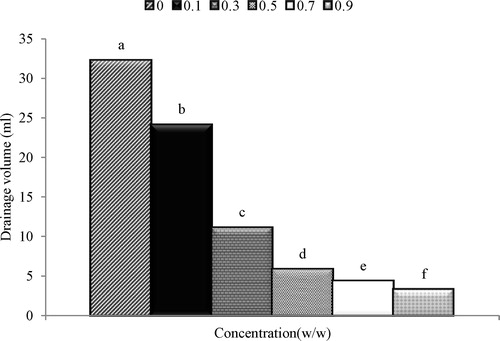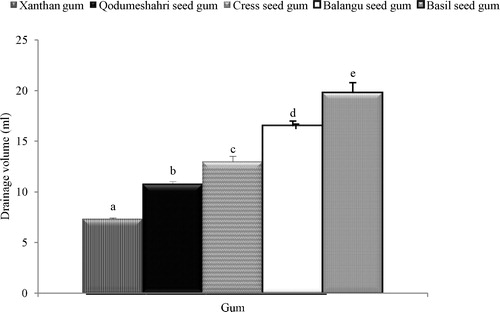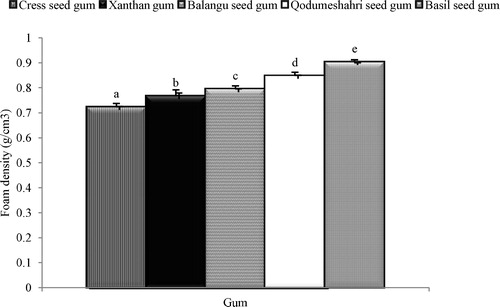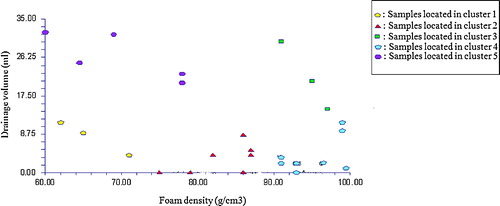 ?Mathematical formulae have been encoded as MathML and are displayed in this HTML version using MathJax in order to improve their display. Uncheck the box to turn MathJax off. This feature requires Javascript. Click on a formula to zoom.
?Mathematical formulae have been encoded as MathML and are displayed in this HTML version using MathJax in order to improve their display. Uncheck the box to turn MathJax off. This feature requires Javascript. Click on a formula to zoom.Abstract
White mushrooms are among the most popular edible fungi, and consumption has increased substantially because of their nutritional properties. Fresh mushrooms have a high moisture content and respiration rate and therefore have short shelf life; preservation is therefore necessary. One approach to increasing consumption is to convert mushroom puree into dried powder for use as an ingredient of foods. For instance, mushroom powder could be a functional or nutritional addition to instant soup, noodles, sausage powder, sauces, snacks, extruded baby foods and cereal products. For this purpose, foam mat drying has been introduced.
1 Introduction
The white button mushroom (Agaricus bisporus) is one of the most widely consumed edible fungus in the world and is cultivated in more than 70 countries [Citation1]. The highly perishable nature of the mushroom led researchers to find new methods for extending its shelf life. Foam mat drying is an economical method for drying liquid and semi-liquid foods. In this process, liquid or semi-liquid food concentrate is converted to a stable foam with foaming agents (surfactants) or foam stabilizers and then dried at relatively low temperatures, with a short drying time [Citation2,Citation3]. The preparation of stable foam plays a major role in foam mat drying. For this purpose, the addition of foaming agents and foam stabilizers is necessary. Foam expansion and stability are the most important characteristics. Foam expansion can be determined from its expansion ratio or density, whereas foam stability is determined from drainage volume, film rupture and disproportionation of bubbles [Citation4,Citation5]. Many foods naturally contain soluble proteins, which can contribute to the formation and stability of the foam structure after whipping [Citation6]. Previous work [Citation7] and our preliminary experiments show that mushroom proteins capably act as foaming agents for foam formation, but the foams are not stable enough for foam mat drying, and stabilizers must be added. Hydrocolloid in foams provides a yield value in the liquid phase that retains the bubbles in place [Citation8].
Table 3 Cluster standard deviations for variables.
Table 4 Cluster means for variables.
Xanthan gum is a unique commercial gum that is widely used as a food hydrocolloid in suspensions, emulsions and foams for a number of reasons, including its solubility in hot or cold water, its stability over a wide range of temperatures and pHs, its high solution viscosity at low concentrations, its excellent compatibility with salt and other characteristics [Citation9]. Muthukumaran [Citation4] studied the effects of foam stabilizers (methylcellulose, propylene glycol alginate and xanthan gum) on the stability of egg white foam and found that 0.125% xanthan gum was sufficient to produce satisfactory egg white foam.
The demand for new sources of food hydrocolloids with specific functionality has increased in recent years [Citation10]. Researchers have found that mucilaginous extracts from plants can be used as hydrocolloids in food formulations and are acceptable to consumers [Citation11,Citation12]. The seeds of balangu (Lallemantia royleana), basil (Ocimum basilicum), cress (Lepidium sativum) and qodume shahri (Lepidum perfoliatum), which are endemic in Iran, produce large amounts of mucilaginous substances when soaked in water. Some of these plants have health-promoting properties and have been used in traditional Iranian medicine [Citation11].
The objective of the present study was to investigate and compare the effects of various endemic hydrocolloids, qodume shahri seed gum, basil seed gum, balangu seed gum and cress seed gum, with xanthan gum for use as commercial hydrocolloids for the foaming properties of white button mushroom puree, in order to select a suitable stabilizer for white button mushroom puree foam. Data were clustered with the K-means algorithm on the basis of their similarities in the same categories. Clustering was used successfully for investigating the effects of polysaccharides and soy protein hydrolysis on foaming properties by Martínez et al. [Citation13], but to our knowledge there are no published data on endemic hydrocolloids such as seed gums from qodume shahri, basil, balangu and cress.
2 Materials and methods
2.1 Materials
Fresh white button mushroom (A. bisporus) were purchased from a local manufacturer in Mashhad during the first day of harvest in autumn 2011. Xanthan gum was obtained from Sigma Chemical Co., USA, and balangu seed, qodume shahri seed, basil seed and cress seed were purchased from the local medical plant market in Mashhad, Iran.
2.2 Extraction procedure
Crude extract powder of the four seed gums were prepared according to Mohammad Amini and Hadad [Citation14], Koocheki et al. [Citation11], Razavi et al. [Citation15] and Karazhiyan et al. [Citation16]. The apparent viscosity, yield and protein content of the hydrocolloids at optimized points are presented in .
Table 1 Apparent viscosity, yield and protein content of endemic hydrocolloids.
2.3 Sample preparation
2.3.1 Preparation of mushroom puree
The mushrooms were sliced with a stainless-steel knife, immersed in 2% (w/w) sodium metabisulphite solution for 10 min and then rinsed with distilled water to prevent discoloration during crushing. The sliced mushrooms were crushed in a kitchen blender (Tefal, 210 W) at 15,000 rpm for 1 min to obtain a homogeneous puree. During the foaming trial, the desired concentration of mushroom puree was prepared by adding a calculated amount of distilled water.
2.3.2 Preparation of gum solutions
Hydrocolloid solutions were prepared by dissolving an appropriate amount of the selected gums powder in distilled water and stirring vigorously with a magnetic stirrer until a uniform solution was obtained and were kept in a refrigerator for 18–24 h to complete hydration. Hydrocolloid solutions were prepared to give final concentrations of 0.1, 0.3, 0.5, 0.7 and 0.9% w/w.
2.4 Foaming trial
2.4.1 Foam formation
To prepare 100 g mushroom puree suspension, the appropriate amounts of gum solution, mushroom puree and distilled water were added and whipped at ambient temperature with a kitchen aid mixer (Model No. SM88, Sony) at 1500 rpm for 3 min.
2.4.2 Determination of foam density
Foam density was determined by weighing 50 ml of the mixture in a 50-ml measuring cylinder. Transfer of the foam was performed carefully to avoid destroying the structure and trapping air voids when filling the cylinder. The determinations were made in duplicate, and average values are reported [Citation17].
2.4.3 Determination of drainage volume
Foam drainage was determined by the methods described by Sauter and Montoure [Citation18] and Bag et al. [Citation5], with some modifications to evaluate foam stability. In the modified method, foam was placed in an 80-mm Buchner filter, covered with mesh cloth and placed in a 50-ml graduated cylinder. The liquid was separated from the foam after 30 min, as a result of drainage and recorded.
2.5 Statistical analysis
An experimental design with a completely randomized factorial model and at least two replications for each treatment was used. Statistical analysis of the data was performed by analysis of variance (ANOVA), and Duncan's multiple comparison tests were applied to determine differences between means (p < 0.05) with SPSS software (version 16.0) for Windows.
2.5.1 Cluster analysis
The results of treatments were clustered into the same categories on the basis of their foaming properties. Thus, treatments with similar drainage volume and foam density were placed in the same cluster, and hydrocolloids with appropriate properties were selected. The K-means algorithm was applied, as it can divide N observations with P dimensions (variables) into K clusters so that the within-cluster sum of squares is minimized. In this technique, N rows (observations) are separated into K groups, in which the kth cluster contains nk observations, and each row includes P variables. The data are standardized by subtracting the variable mean and dividing by the standard deviation. The standardized data components are referred to as zij.
The goodness of fit criterion is used to compare various cluster configurations on the basis of within-cluster sum of squares, WSSK (Eq. Equation(1)(1)
(1) ),
(1)
(1) where Cik is the average (centre) value of the ith variable in the kth cluster.
The percent of variation is calculated as shown in Eq. Equation(2)(2)
(2)
(2)
(2)
Various goodness-of-fit tests are used to determine the optimum number of clusters [Citation19]. In this study, data were clustered with NCSS software version 2007.
3 Results and discussion
3.1 Foam density
Foams are two-phase systems consisting of a dispersed phase (usually air) and a continuous phase [Citation4]. Foam density depends on the ratio of the dispersed phase to the continuous phase, reflecting the amount of air incorporated in the foam during formation. For example, a high foam density indicates that little air was trapped, giving low foam expansion [Citation5].
The effects of gums concentrations on the density of white button mushroom puree foams are presented in . ANOVA showed that increasing the concentration of the hydrocolloids in white button mushroom puree foam significantly increased the foam density (p < 0.05) (). Therefore, gum concentration had an adverse effect on foam expansion.
Fig. 1 Effect of gums concentrations on foam density. Note: The level of statistical significance was determined at 95% probability. The different letters mean significant difference in this level.

Table 2 Successive mean squares from ANOVA for foam density and foam stability.
The main mechanism of this phenomenon could be the greatly increased viscosity of the aqueous phase due to the addition of high concentrations of gum, so that air cannot enter the system during whipping and reduce foam density [Citation20], as shown by studies on star and bael fruit foams [Citation5,Citation17].
The effects of the investigated gums on the density of white button mushroom puree foams are shown in . Cress seed gum had a positive effect on foam density, which was comparable to that of xanthan gum (p < 0.05). Although the reason for this effect is not known yet, the foaming properties of cress seed gum may be due to its lower viscosity as compared with most of other hydrocolloids, such as xanthan (). The high foaming capacity of cress seed gum is also related to its surface activity, which can be attributed to the presence of a macromolecular component, which is either a glycoprotein or a polysaccharide–protein [Citation21].
3.2 Foam stability
Drainage is widely used for evaluating foam stability. Drainage is the flow of liquid through foam driven by capillary forces or external forces such as gravity. The result is thinning of the lamellae (the thin wall of a bubble), followed by film rupture, which finally leads to foam destruction [Citation22]. As expected, lower drainage volumes resulted in more stable foam. ANOVA indicated that the hydrocolloids tested as foam stabilizers had a significant effect on the stability of white button mushroom puree foam (p < 0.05) ( and ). Thus, foam stability increased with increasing concentrations of the hydrocolloids. These positive effects are due to the increasing interfacial viscoelasticity of foam lamellae [Citation23].
Fig. 3 Effect of gums concentrations on drainage volume. Note: The level of statistical significance was determined at 95% probability. The different letters mean significant difference in this level.

The hydrophobic nature of hydrocolloids prevents them from being absorbed at the plateau borders, thus strengthening bubble walls and subsequently improving the stability of the foam [Citation24]. Our results are in agreement with those of Karim and Wai [Citation17], Makri and Doxastakis [Citation20], Muthukumaran [Citation4] and Raharitsifa et al. [Citation25].
As shown in , xanthan gum had the greatest effect on foam stability, although the effect of qodume shahri seed gum was similar. The high relative molecular mass and gelation behaviour of polysaccharides like qodume shahri seed gum increases the viscosity of the aqueous phase, leading to the creation a network structure in the bulk phase and slowing drainage of foams [Citation24], but higher concentrations of qodume shahri seed gum prevent air from entering the system.
Fig. 4 Drainage volume in white button mushroom puree foam at different gums. Note: The level of statistical significance was determined at 95% probability. The different letters mean significant difference in this level.

A comparison of drainage volume as a function of the concentration of hydrocolloids is shown in . Addition of the gums as foam stabilizers clearly stabilized white button mushroom puree foam, whereas foam drainage without stabilizer increased rapidly. Balangu and basil seed gums had little effect on the stability of foam at low concentrations but greater effects at higher concentrations.
As shown in , xanthan gum at 0.3%, w/w provides sufficient stability for foam. Muthukumaran [Citation4] also reported a strong effect of xanthan gums as stabilizers, and Herbst et al. [Citation26] reported that even low concentrations conferred high viscosity. The stabilizing effects of xanthan gum are due not only to viscosity but also xanthan to decreasing the forces exerted by the liquid, thus forming a better solution and avoiding drainage phenomena [Citation27].
3.3 Cluster analysis
In order to categorize similar hydrocolloids, we used K-means clustering with five clusters (). Seed gums in the cluster of samples with low drainage volume and low foam density were assumed to be ideal for use in the preparation of white button mushroom puree foam. and show the means and standard deviations of each of the variables in each cluster, and the relative distance of each row from the cluster centre is presented in . As expected, the distance from each point to its centre is much shorter than the distance from the point to the other centres, indicating that the cluster structure is acceptable.
Table 5 Relative distance of each row from the cluster centre.
As shown in , the first cluster contained samples with minimum foam density and a relatively low drainage volume. Xanthan gum at a concentration of 0.1%, w/w and cress seed gum at concentrations of 0.3% and 0.5%, w/w were located in cluster 1 (). The seed gums in the other clusters were not suitable for stabilizing white button mushroom puree foam, because the foam density was very high or the drainage volume was undesirable. Hence, xanthan gum and cress seed gum at low concentrations were selected for optimizing white button mushroom puree foam.
4 Conclusions
The effects of four new Iranian sources of hydrocolloid—seed gums from qodume shahri, basil, balangu and cress—with xanthan gum as commercial hydrocolloid on foaming properties of white button mushroom puree were studied. Cress seed gum was found to have a positive effect on foaming capacity in white button mushroom puree, comparable to that of xanthan gum. Qodume shahri seed gum at a higher concentration was a suitable stabilizing agent as compared with xanthan gum, but a reduction in foam density due to increasing viscosity led to its rejection for use as a stabilizing agent in foam systems. Overall evaluation of the results of clustering and statistical analysis led to the conclusion that xanthan gum at 0.1 w/w and cress seed gum at 0.3 and 0.5 w/w are suitable for use in the formulation of white button mushroom puree foam for further processing, especially drying. Use of cress seed gum as a substitute for xanthan gum in foam products would be advantageous because of its medicinal properties.
Notes
Peer review under responsibility of Taibah University
References
- A.SrivastavaA.SinghR.RajaR.ArunachalamShelf life extension of fresh mushrooms (Agaricus bisporus) by application of tomato pasteInt. J. Eng. Sci. Technol.22010783786
- C.RattiT.KudraDrying of foamed biological materials: opportunities and challengesDrying Technol.24200611011108
- D.M.KadamR.T.PatilP.KaushikP. Foam mat drying of fruit and vegetable productsS.V.JangamC.L.LawA.S.MujumdarDrying of Foods, Vegetables and Fruits12010Central Institute of Post-Harvest Engineering and TechnologyLudhiana113124
- A.MuthukumaranFoam Mat Freeze Drying of Egg White and Mathematical Modeling (MSc Thesis)2007Department of Bioresource Engineering, Macdonald Campus of McGill UniversityMontreal
- S.K.BagP.P.SrivastavH.N.MishraOptimization of process parameters for foaming of bael (Aegle marmelos L.) fruit pulpFood Bioprocess. Technol.4201114501458
- R.ThuwapanichayananS.PrachayawarakornS.SoponronnaritDrying characteristics and quality of banana foam matFood Eng.862008573583
- M.O.AremuS.K.BasuS.D.GyarA.GoyalP.K.BhowmikS.Datta BanikProximate composition and functional properties of mushroom flours from Ganoderma spp., Omphalotus olearius (DC.) Sing. and Hebeloma mesophaeum (Pers.) Quél, used in Nasarawa State, NigeriaMalays. J. Nutr.152009233241
- A.PrinE.DickinsonG.StainsbyAdvances in Food Emulsions and Foam1988Elsevier Applied ScienceLondon91
- J.N.BemillerR.L.WhistlerCarbohydratesO.R.FennemaFood Chemistry3rd ed.1996Marcel DekkerNew York157233
- P.A.WilliamsG.O.PhillipsIntroduction to food hydrocolloidsG.O.PhillipsP.A.WilliamsHandbook of Hydrocolloids2000CRC PressNew York119
- A.KoochekiA.R.TaherianS.M.A.RazaviA.BostanResponse surface methodology for optimization of extraction yield, viscosity, hue and emulsion stability of mucilage extracted from Lepidium perfoliatum seedsFood Hydrocolloids23200923692379
- B.EmadzadehS.M.A.RazaviM.HashemiViscous flow behavior of low calorie pistachio butter: a response surface methodologyInt. J. Nuts Related Sci.220113747
- K.D.MartínezF.MillánA.M.R.PilosofEffects of soy protein hydrolysis and polysaccharides addition on foaming properties studied by cluster analysisFood Hydrocolloids25201116671676
- A.Mohammad AminiM.H.Hadad KhodaparastModeling and optimization of mucilage extraction from Lallemantia royleana: a response surface genetic algorithm approachEFFoST/EHEDG Joint ConferenceLisbon2007
- S.M.A.RazaviS.A.MortazaviL.Matia MerinoS.H.Hosseini ParvarA.MotamedzadeganE.KhanipourOptimization study of gum extraction from basil seeds (Ocimum basilicum L.)Int. J. Food Sci. Technol.44200917551762
- H.KarazhiyanS.M.A.RazaviG.O.PhillipsExtraction optimization of a hydrocolloid extract from cress seed (Lepidium sativum) using response surface methodologyFood Hydrocolloids252011915920
- A.A.KarimC.C.WaiCharacteristics of foam prepared from starfruit (Averrhoa carambola L.) puree by using methyl celluloseFood Hydrocolloids131999203210
- E.A.SauterJ.E.MontoureThe relationship of lysosyme content of egg white to volume and stability of foamsJ. Food Sci.371972918920
- J.L.HintzeNCSS Help System2007KaysvilleUtah
- E.MakriG.DoxastakisStudy of emulsions and foams stabilized with Phaseolus vulgaris or Phaseolus coccineus with the addition of xanthan gum or NaClJ. Sci. Food Agric.86200618631870
- S.NajiH.KarazhiyanS.M.A.RazaviEffect of thermal treatments on functional properties of cress seed (Lepidium sativum) and xanthan gums: a comparative studyFood Hydrocolloids2820117581
- W.DrenckhanS.LangevinMonodisperse foams in one to three dimensionsCurr. Opin. Colloid Interface Sci.152010341358
- J.P.HellerM.S.KuntamukkulaCritical review of the foam rheology literatureInd. Eng. Chem. Res.261987318325
- E.M.PapalamprouE.A.MakriV.D.KiosseoglouG.I.DoxastakisEffect of medium molecular weight xanthan gum in rheology and stability of oil in water emulsion stabilized with legume proteinsJ. Sci. Food Agric.85200519671973
- N.RaharitsifaD.B.GenoveseC.RattiCharacterization of apple juice foams for foam mat drying prepared with egg white protein and methylcelluloseJ. Food Sci.712006142151
- H.HerbstA.SchumpeW.DeckerXanthan production in stirred tank fermenters: oxygen transfer and scaleupChem. Eng. Technol.151992425434
- C.L.MottN.S.HettiarachchyM.QiEffect of xanthan gum on enhancing the foaming properties of whey protein isolateJ. Am. Oil Chem. Soc.76199913831386



